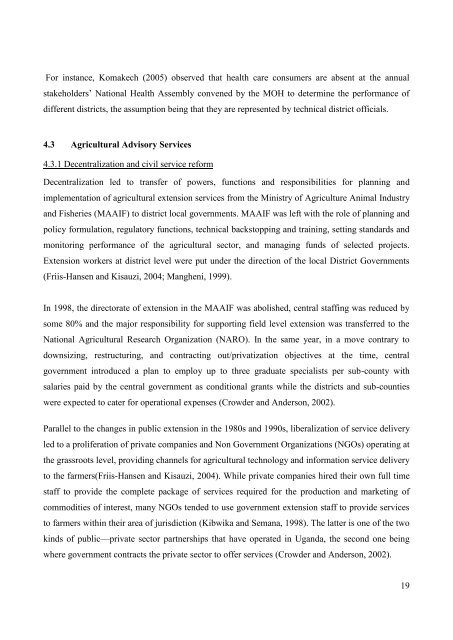Decentralisation and Rural Service Delivery in Uganda
Decentralisation and Rural Service Delivery in Uganda
Decentralisation and Rural Service Delivery in Uganda
Create successful ePaper yourself
Turn your PDF publications into a flip-book with our unique Google optimized e-Paper software.
For <strong>in</strong>stance, Komakech (2005) observed that health care consumers are absent at the annualstakeholders‘ National Health Assembly convened by the MOH to determ<strong>in</strong>e the performance ofdifferent districts, the assumption be<strong>in</strong>g that they are represented by technical district officials.4.3 Agricultural Advisory <strong>Service</strong>s4.3.1 Decentralization <strong>and</strong> civil service reformDecentralization led to transfer of powers, functions <strong>and</strong> responsibilities for plann<strong>in</strong>g <strong>and</strong>implementation of agricultural extension services from the M<strong>in</strong>istry of Agriculture Animal Industry<strong>and</strong> Fisheries (MAAIF) to district local governments. MAAIF was left with the role of plann<strong>in</strong>g <strong>and</strong>policy formulation, regulatory functions, technical backstopp<strong>in</strong>g <strong>and</strong> tra<strong>in</strong><strong>in</strong>g, sett<strong>in</strong>g st<strong>and</strong>ards <strong>and</strong>monitor<strong>in</strong>g performance of the agricultural sector, <strong>and</strong> manag<strong>in</strong>g funds of selected projects.Extension workers at district level were put under the direction of the local District Governments(Friis-Hansen <strong>and</strong> Kisauzi, 2004; Mangheni, 1999).In 1998, the directorate of extension <strong>in</strong> the MAAIF was abolished, central staff<strong>in</strong>g was reduced bysome 80% <strong>and</strong> the major responsibility for support<strong>in</strong>g field level extension was transferred to theNational Agricultural Research Organization (NARO). In the same year, <strong>in</strong> a move contrary todownsiz<strong>in</strong>g, restructur<strong>in</strong>g, <strong>and</strong> contract<strong>in</strong>g out/privatization objectives at the time, centralgovernment <strong>in</strong>troduced a plan to employ up to three graduate specialists per sub-county withsalaries paid by the central government as conditional grants while the districts <strong>and</strong> sub-countieswere expected to cater for operational expenses (Crowder <strong>and</strong> Anderson, 2002).Parallel to the changes <strong>in</strong> public extension <strong>in</strong> the 1980s <strong>and</strong> 1990s, liberalization of service deliveryled to a proliferation of private companies <strong>and</strong> Non Government Organizations (NGOs) operat<strong>in</strong>g atthe grassroots level, provid<strong>in</strong>g channels for agricultural technology <strong>and</strong> <strong>in</strong>formation service deliveryto the farmers(Friis-Hansen <strong>and</strong> Kisauzi, 2004). While private companies hired their own full timestaff to provide the complete package of services required for the production <strong>and</strong> market<strong>in</strong>g ofcommodities of <strong>in</strong>terest, many NGOs tended to use government extension staff to provide servicesto farmers with<strong>in</strong> their area of jurisdiction (Kibwika <strong>and</strong> Semana, 1998). The latter is one of the twok<strong>in</strong>ds of public—private sector partnerships that have operated <strong>in</strong> Ug<strong>and</strong>a, the second one be<strong>in</strong>gwhere government contracts the private sector to offer services (Crowder <strong>and</strong> Anderson, 2002).19








